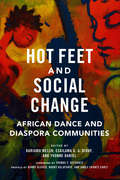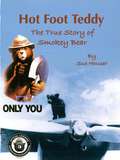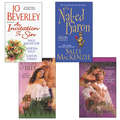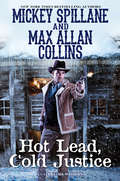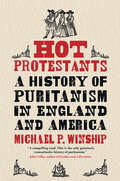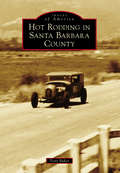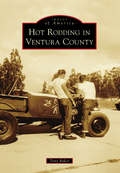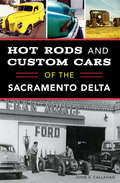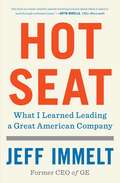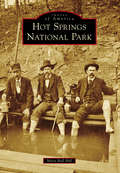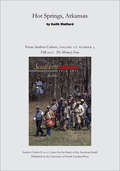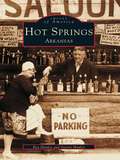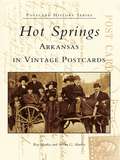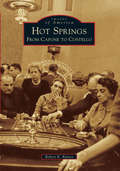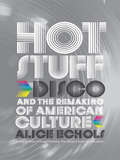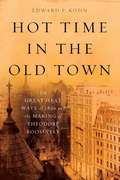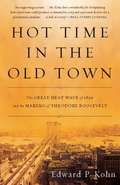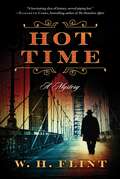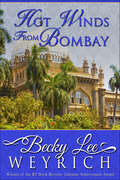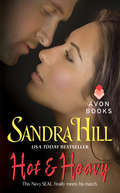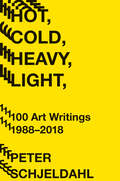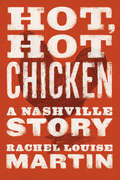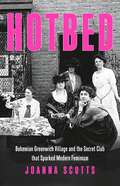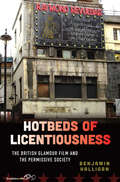- Table View
- List View
Hot Feet and Social Change: African Dance and Diaspora Communities
by Yvonne Daniel Kariamu Welsh Esailama G. A. DioufThe popularity and profile of African dance have exploded across the African diaspora in the last fifty years. Hot Feet and Social Change presents traditionalists, neo-traditionalists, and contemporary artists, teachers, and scholars telling some of the thousands of stories lived and learned by people in the field. Concentrating on eight major cities in the United States, the essays explode myths about African dance while demonstrating its power to awaken identity, self-worth, and community respect. These voices of experience share personal accounts of living African traditions, their first encounters with and ultimate embrace of dance, and what teaching African-based dance have meant to them and their communities. Throughout, the editors alert readers to established and ongoing research, and provide links to critical contributions by African and Caribbean dance experts.Contributors: Ausettua Amor Amenkum, Abby Carlozzo, Steven Cornelius, Yvonne Daniel, Charles “Chuck” Davis, Esailama G. A. Diouf, Indira Etwaroo, Habib Iddrisu, Julie B. Johnson, C. Kemal Nance, Halifu Osumare, Amaniyea Payne, William Serrano-Franklin, and Kariamu Welsh
Hot Foot Teddy The True Story of Smokey Bear: The True Story Of Smokey Bear
by Sue HouserWritten for children and adults alike, Hot Foot Teddy contains the true history of Smokey Bear. A portion of the proceeds benefit the Smokey Bear Forest Fire Prevention Program. Photographs, illustrations and antique images of Smokey Bear are included.
Hot Historicals Bundle with An Invitation to Sin, The Naked Baron, When His Kiss Is Wicked, & Mastering the Marquess
by Jo Beverley Kaitlin O'RileyHot Historicals Bundle An Invitation to Sin, Forbidden Affections by Jo Beverley, The doors to romance can be found in the most unexpected places, especially when the notorious Earl of Carne moves into the mansion neighboring Anna Featherstone's London townhouse. Who knocks first remains the only question. . . The Pleasure Of A Younger Lover by Vanessa Kelly, Clarissa Middleton cannot resist the ardent kisses of Captain Christian Archer, though they must meet in secret or risk the censure of London society. In each other's arms, desire and love melt two hearts into one. . . The Naked Prince by Sally MacKenzie, Josephine Atworthy is shocked by the goings-on at her rich neighbor's house party. Quite shocked. But her demure charm beguiles a mysterious nobleman, who begs a kiss--then another. And in a twinkling they fall head over heels in love. . . A Summer Love Affair by Kaitlin O'Riley, Unmarried. Unconventional. Unchaperoned. Miss Charlotte Wilson is free to do as she pleases and Gavin Ellsworth is dashing. Summer in Spain at a secluded villa is about to get a whole lot hotter. . . The Naked Baron, Tell Me What You Want, New to London society and rather. . .awkward. . .Lady Grace Belmont would just as soon hide behind the palm trees as dance with a man she doesn't know. But Baron Dawson is on the hunt for a wife. Grace's generous curves and remarkable height do not intimidate him. In fact, it would be more accurate to describe his reaction to the charming newcomer as lust. Before Grace can so much as gather her thoughts, she finds herself in his arms, committing one shocking impropriety after another. The Baron's devilish attractiveness--to say nothing of his splendid muscles--is simply impossible to resist. Her beloved aunt and chaperone advises patience, but Grace is not about to listen. The handsome baron is whispering such delightful things in her ear. . .
Hot Lead, Cold Justice (A Caleb York Western #5)
by Max Allan Collins Mickey SpillaneLegendary crime writer Mickey Spillane&’s celebrated tin-star hero Caleb York returns in the explosive Western saga by New York Times bestselling author Max Allan Collins. This time, the revered New Mexico gunhand unloads his .44 in a brewing storm brutal enough to freeze the blood. A killer blizzard sweeping across the Southwest threatens the livelihoods of everyone in the town of Trinidad. But it&’s two gunshots that fell Sheriff Caleb York&’s unlucky deputy. As sure as the blood pooling in the snow, York knows it was a case of mistaken identity. The bullets were meant for him. It&’s the first nasty step in a plan rustled up by former Quantrill&’s Raider Luke &“Burn &’Em&” Burnham—eliminate the law, corral a team to rob a bank in booming Las Vegas, New Mexico, then lay low. With a treacherous local merchant for cover, and York out of the picture, all they&’ll have to do is wait for the calm. Then they get wind of one little hitch: not only is York still alive, but he&’s gunning for justice—and revenge. As the winter weather bears down, the stir-crazy outlaws aim to finish what they started—take down York and disappear into the blinding storm. As a chilling cat-and-mouse begins, York isn&’t about to let Burnham and his damnable gang get away. It&’d be a cold day in hell if he did.
Hot Protestants: A History of Puritanism in England and America
by Michael P. Winship&“The rise and fall of transatlantic puritanism is told through political, theological, and personal conflict in this exceptional history.&” (Publishers Weekly, starred review) Begun in the mid-sixteenth century by Protestant nonconformists keen to reform England&’s church and society while saving their own souls, the puritan movement was a major catalyst in the great cultural changes that transformed the early modern world. Providing a uniquely broad transatlantic perspective, this groundbreaking volume traces puritanism&’s tumultuous history from its initial attempts to reshape the Church of England to its establishment of godly republics in both England and America and its demise at the end of the seventeenth century. Shedding new light on puritans whose impact was far-reaching as well as on those who left only limited traces behind them, Michael Winship delineates puritanism&’s triumphs and tribulations and shows how the puritan project of creating reformed churches working closely with intolerant godly governments evolved and broke down over time in response to changing geographical, political, and religious exigencies. &“Among the fairest and most readable accounts of the glorious failure that was trans-Atlantic Puritanism.&” --The Wall Street Journal &“Exhilarating popular history . . . convincingly captures in one bold retelling decades of scholarship on Puritanism&’s origins, developments and characteristics&” —Times Literary Supplement &“Winship has established himself as a leading authority on the history of the Puritans. While many works have focused on a specific aspect of Puritan history, . . . there are fewer works that show Puritanism as a multinational movement in Europe and the Americas. This book fills those gaps.&” —Library Journal A Choice Outstanding Academic Titles
Hot Rodding in Santa Barbara County (Images of America)
by Tony BakerCalifornia's central coast was fertile ground for hot rodding, and all motor sports in general, during the 1940s and 1950s. Hot Rodding in Santa Barbara County takes the reader back in time with a collection of remarkable photographs from the earliest days of the hot rod movement. This book includes images of the first drag strips in the country, rough-and-tumble jalopy racing, early road-racing action, and lots of great hot rods and customs. Follow local hot-rodders as they take trips to El Mirage dry lake and the world-famous salt flats at Bonneville, Utah, and visit a long-lost world as seen through photographs taken from the personal albums of people who contributed to the birth of a culture that would spread across the nation.
Hot Rodding in Ventura County (Images of America)
by Tony BakerStretching from Ventura to Santa Maria, California, a vibrant and colorful community of hot rod clubs bloomed throughout the middle of the 20th century. Hot Rodding in Ventura County takes a look at the people, places, and, above all, the cars that made up this historic period in automotive culture. Take a look into the golden years of hot rodding through vintage images of the first national championship drag races; visit long-lost drag strips such as Goleta, Saugus, and Santa Maria; and gain access to hot rodding's paramount clubs like the Motor Monarchs, the Kustomeers, and the Pharaohs.
Hot Rods and Custom Cars of the Sacramento Delta
by John V. CallahanThe Sacramento Delta has produced some of the finest hot rods and custom cars ever made. The passion of the area's builders is evident in the incredible cars they created, which drew nationwide attention. Harry Westerguard, who taught George Barris bodywork, worked on the second "America's Most Beautiful Roadster"----a 1923 "T" that was a style-setter for its day. Bob Dron built his first custom when he was only fifteen and a half, and Lenny Byer created his own "Candy Apple Red" in Rio Vista. Detroit might have had its vision, but the Delta region built its own. Discover the stories behind the cars and their builders as author John V. Callahan takes us on a trip down memory lane.
Hot Seat: What I Learned Leading a Great American Company
by Jeff ImmeltA memoir of successful leadership in times of crisis: the former CEO of General Electric, named one of the &“World&’s Best CEOs&” three times by Barron&’s, shares the hard-won lessons he learned from his experience leading GE immediately after 9/11, through the economic devastation of the 2008–09 financial crisis, and into an increasingly globalized world.In September 2001, Jeff Immelt replaced the most famous CEO in history, Jack Welch, at the helm of General Electric. Less than a week into his tenure, the 9/11 terrorist attacks shook the nation, and the company, to its core. GE was connected to nearly every part of the tragedy—GE-financed planes powered by GE-manufactured engines had just destroyed real estate that was insured by GE-issued policies. Facing an unprecedented situation, Immelt knew his response would set the tone for businesses everywhere that looked to GE—one of America&’s biggest and most-heralded corporations—for direction. No pressure. Over the next sixteen years, Immelt would lead GE through many more dire moments, from the 2008–09 Global Financial Crisis to the 2011 meltdown of Fukushima&’s nuclear reactors, which were designed by GE. But Immelt&’s biggest challenge was inherited: Welch had handed over a company that had great people, but was short on innovation. Immelt set out to change GE&’s focus by making it more global, more rooted in technology, and more diverse. But the stock market rarely rewarded his efforts, and GE struggled. In Hot Seat, Immelt offers a rigorous, candid interrogation of himself and his tenure, detailing for the first time his proudest moments and his biggest mistakes. The most crucial component of leadership, he writes, is the willingness to make decisions. But knowing what to do is a thousand times easier than knowing when to do it. Perseverance, combined with clear communication, can ensure progress, if not perfection, he says. That won&’t protect any CEO from second-guessing, but Immelt explains how he&’s pushed through even the most withering criticism: by staying focused on his team and the goals they tried to achieve. As the business world continues to be rocked by stunning economic upheaval, Hot Seat is an urgently needed, and unusually raw, source of authoritative guidance for decisive leadership in uncertain times.
Hot Springs National Park
by Mary Bell HillHot Springs was one of the first areas set aside as a federal land reservation in 1832--predating the first national park at Yellowstone by 40 years. In 1921, it was officially designated a national park. Physically the smallest of the 59 US national parks today, Hot Springs measures just larger than 5,500 acres. Its 47 on-site springs produce more than 700,000 gallons of thermal water per day. From early natives who quarried novaculite found in the surrounding hills to famous politicians, performers, and athletes, people have been coming to these springs for thousands of years to partake in the supposed healing powers of the water. Pres. Franklin Roosevelt, boxer Jack Dempsey, and French opera diva Lily Pons are a few of the visitors who made the trek to the "Valley of the Vapors." The history of Hot Springs National Park revolves around peoples' interactions with its thermal water.
Hot Springs, Arkansas
by Keith MaillardHot Springs, Arkansasby Keith MaillardWorld War II-era Hot Springs is the foundation for this author's story, a tale about his family's crumbling dynamics in troublesome times."'Well, of course I remember Pearl Harbor,' my mother says, the tone of her voice adding,What do you think I am, an idiot? She and my grandmother were working in the shop when they heard on the radio that the Japanese had bombed Pearl Harbor. She was five months pregnant with me. It was a Sunday. They'd never heard of Pearl Harbor."
Hot Springs, Arkansas (Images of America)
by Ray Hanley Steven HanleyFrom its rise in the 1800s until well into the twentieth century, Hot Springs was a famed resort known worldwide. The grand hotels and world-class bath houses that sprang up around the government-protected springs drew countless visitors, ranging from the famous and wealthy to those of humble means, all seeking the health and pleasure promised by the Spa City's promoters. In the words of a railroad tourist guidebook from about 1910, "A stay at Hot Springs, be it ever so brief, always remains a pleasant memory afterward. It was the writer's good fortune to spend a few days at this popular resort--not as an invalid, I am happy to say, but as a tourist--and I certainly never bathed in more delightful water than that which flows so abundantly from the hot springs of Arkansas. There is buoyancy, a magnetism about it that is simply indescribable."Such has been the experience of countless visitors over the years. Readers will find much of the history of this storied resort in Hot Springs, Arkansas, which is profusely illustrated with vintage postcards and photographs, all carefully interpreted by the authors, Ray and Steven Hanley, with research assistance from Mark Blaeuer of the Hot Springs National Park staff.
Hot Springs, Arkansas in Vintage Postcards (Postcard History Series)
by Ray Hanley Steven G. HanleyFrom the 1890s to the 1920s, the postcard was an extraordinarily popular means of communication, and many of the postcards produced during this "golden age" can today be considered works of art. Early in the century, Hot Springs was among the most noted resorts in the nation. Its Victorian wonders drew thousands of visitors to partake in the hot mineral waters that bubbled from the earth. In the words written on one card in 1910, "Many people of wealth are here from Chicago and New York. Uncle Billy went to the horse show ball at the Eastman Hotel with an ex-wife of a millionaire. Andrew Carnegie and young Jay Gould were at the ball." Showcased in this fascinating collection are over two hundred postcardsfrom 1900 to 1960. The images are accompanied by the actual penned messages of visitors and extensively researched historical facts.
Hot Springs: From Capone to Costello (Images of America)
by Robert K. RainesIn the late 1800s, Hot Springs, Arkansas, was a small town with a big attraction: hot thermal water. The federal government took possession of the downtown-area springs, and bathhouse row was born, along with the first property that would be considered a national park. Following not too far behind were great entrepreneurs who brought in gambling and prostitution to go with the area's leading industry: moonshining. By the time the 20th century rolled in, Hot Springs was booming with tourists and became America's first resort. In the early 1930s, former New York gangster Owen Madden took up residence in the spa city, and things became very organized. Gangland luminaries from Al Capone to Frank Costello made regular pilgrimages over the next few decades to what was referred to as "the loose buckle in the Bible Belt."
Hot Stuff: Disco and the Remaking of American Culture
by Alice EcholsDisco thumps back to life in this pulsating look at the culture and politics that gave rise to the music. In the 1970s, as the disco tsunami engulfed America, the question, "Do you wanna dance?" became divisive, even explosive. What was it about this music that made it such hot stuff? In this incisive history, Alice Echols reveals the ways in which disco, assumed to be shallow and disposable, permanently transformed popular music, propelling it into new sonic territory and influencing rap, techno, and trance. This account probes the complex relationship between disco and the era's major movements: gay liberation, feminism, and African American rights. But it never loses sight of the era's defining soundtrack, spotlighting the work of precursors James Brown and Isaac Hayes, its dazzling divas Donna Summer and the women of Labelle, and some of its lesser-known but no less illustrious performers like Sylvester. You'll never say "disco sucks" again after reading this fascinating account of the music you thought you hated but can't stop dancing to.
Hot Time in the Old Town: The Great Heat Wave of 1896 and the Making of Theodore Roosevelt
by Edward P. KohnA vivid narrative that captures the birth of the progressive era, Hot Time in the Old Town revives the forgotten disaster that almost destroyed a great American city when one of the worst natural disasters in American history, the 1896 New York heat wave killed almost 1,500 people in ten oppressively hot days.
Hot Time in the Old Town: The Great Heat Wave of 1896 and the Making of Theodore Roosevelt
by Edward P. KohnOne of the worst natural disasters in American history, the 1896 New York heat wave killed almost 1,500 people in ten oppressively hot days. The heat coincided with a pitched presidential contest between William McKinley and the upstart Democrat William Jennings Bryan, who arrived in New York City at the height of the catastrophe. As historian Edward P. Kohn shows, Bryan’s hopes for the presidency began to flag amidst the abhorrent heat just as a bright young police commissioner named Theodore Roosevelt was scrambling to mitigate the dangerously high temperatures by hosing down streets and handing out ice to the poor. A vivid narrative that captures the birth of the progressive era, Hot Time in the Old Town revives the forgotten disaster that almost destroyed a great American city.
Hot Time: A Mystery
by W. H. FlintFor fans of The Knick, The Alienist, and The Last Days of Night, an entertaining, atmospheric crime thriller set in the Gilded Age.New York, August 1896. A &“hot wave&” has settled on the city with no end in sight, leaving tempers short and the streets littered with dead horses felled by the heat. In this presidential election year, the gulf between rich and poor has political passions flaring, while anti-immigrant sentiment has turned virulent. At Police Headquarters, the gruff, politically ambitious commissioner Theodore Roosevelt has been struggling to reform his notoriously corrupt department. Meanwhile, the yellow press is ready to pounce on the peccadilloes of the Four Hundred, the city&’s social elite—the better to sell papers with lurid stories and gossip or perhaps profit from a little blackmail on the side. When the body of Town Topics publisher William d&’Alton Mann is found at the foot of the Brooklyn Bridge, any number of his ink-spattered victims may have a motive.Hot Time is an immensely entertaining, deeply researched, and richly textured historical novel set in a period that reflects our own, with cameos by figures ranging from financier J. P. Morgan to muckraking journalist Jacob Riis. Our guides through New York's torrid, bustling streets are Otto &“Rafe&” Raphael from the Lower East Side, one of the first Jewish officers in the heavily Irish force, who finds as many enemies within the department as outside it; Minnie Kelly, the department's first female stenographer; Theodore Roosevelt himself; and the plucky orphan Dutch, one of the city's thousands of newsboys, who may have seen too much.
Hot Wheels: A Photographic Guide to Life-Size Versions of Your Favorite Die-Cast Cars
by Weldon Owen&“Each car is featured in large, exceptionally fine photos, which show off the lines and details of these fabulous fantasy vehicles, both inside and out.&” —Classic American Every year, the legendary Hot Wheels toy company holds its &“Garage of Legends&” contest, in which fans around America compete to have their unique concept car be the next added to the collection. The contest winners and other unique full-size scale models tour Walmart stores around the country; over 110,000 people attended 2019&’s events. This book collects never-before-seen images and descriptions of these one-of-a-kind cars and the people who design them. The cars featured include: 2001 Twin Mill2003 Deora II1968 Beach Bomb1966 Pontiac GTO1971 Chevrolet El Camino2014 Star Wars Darth Vader Car2005 Ford Sema Mustang GTAnd more!
Hot Winds from Bombay
by Becky Lee Weyrich&“Weyrich writes a sensuous love story!&”—Affaire de Coeur The night Persia Whiddington meets handsome Zachariah Hazzard, they find passion in each other&’s arms. But the heat of their desire is too briefly realized before fate tears them apart. Still, Persia&’s heart remains with Zachariah. Determined to reunite with her true love, the young beauty sets out on a journey from the cold climes of Maine to the sultry heat of Bombay. But can she reclaim Zachariah&’s heart before the imminent dangers of her journey claim her life?
Hot and Heavy (Viking Series II #5)
by Sandra HillIn and out, that's the goal as Lt. Ian MacLean prepares for his special ops mission. He leads a team of highly trained Navy SEALs, the toughest, buffest fighting men in the world and he has nothing to lose. Madrene comes from a time a thousand years before he was born, and she has no idea she's landed in the future. After tying him up, the beautiful shrew gives him a tongue-lashing that makes a drill sergeant sound like a kindergarten teacher. Then she lets him know she has her own special way of dealing with over-confident males, and things get . . . Hot & Heavy.
Hot, Cold, Heavy, Light, 100 Art Writings 1988–2018
by Peter Schjeldahl100 key writings from spanning across thirty years of the acclaimed New Yorker art critic’s career.Hot, Cold, Heavy, Light collects 100 key writings by Peter Schjeldahl spinning thirty years, his last twenty as the art critic of the New Yorker. In this unfailingly lucid guide to an art world in constant, dramatic flux, Schjeldahl addresses new artists and Old Masters with the same pitch of acuity, empathy, and wit. No other writer enhances the reader’s experience of art in precise, jargon-free prose as he does, with reviews that are as much essay as criticism.Implicit in Schjeldahl’s role as a frontline critic is a focus on artists, issues, and events of urgent relevance to the culture at large. Holt, Cold, Heavy, Light tells us why we still care about Rembrandt and Mantegna, Matisse and Picasso; takes the measure of contemporaries Basquiat and Holzer, Polke and Kiefer, Sherman and Koons; introduces us to newcomers Kerry James Marshall and Laura Owens; and salutes rediscoveries of Florine Stettheimer, Hélio Oiticica, and Peter Hujar. The book provides essential knowledge to anyone curious about the character, quality, and consequence of art today.The pieces in Hot, Cold, Heavy, Light were compiled and arranged by the critic Jarrett Earnest, with an ear attuned to Schjeldahl’s range of voices. “The effect of reading him in depth, over time,” Earnest says in his introduction, “is like that of great literature. You come away not only with new insights and ideas, but with a feeling of having been granted an extra life.” “This is a rapturous read for art lovers and all who appreciate dynamic critical essays,” —Booklist“Bruce is no longer The Boss; Peter Schjeldahl is! Hot, Cold, Heavy, Light is the apex of artistic criticism and commentary,” —Steve Martin“The great New Yorker art critic writes like an angel about everyone from Vermeer to Picasso, Donatello to Andy Warhol, in beautiful, enjoyable, accessible essays across 30 years,” —Philadelphia Inquirer
Hot, Hot Chicken: A Nashville Story
by Rachel Louise MartinThese days, hot chicken is a &“must-try&” Southern food. Restaurants in New York, Detroit, Cambridge, and even Australia advertise that they fry their chicken &“Nashville-style.&” Thousands of people attend the Music City Hot Chicken Festival each year. The James Beard Foundation has given Prince&’s Chicken Shack an American Classic Award for inventing the dish. But for almost seventy years, hot chicken was made and sold primarily in Nashville&’s Black neighborhoods—and the story of hot chicken says something powerful about race relations in Nashville, especially as the city tries to figure out what it will be in the future.Hot, Hot Chicken recounts the history of Nashville&’s Black communities through the story of its hot chicken scene from the Civil War, when Nashville became a segregated city, through the tornado that ripped through North Nashville in March 2020.
Hotbed: Bohemian Greenwich Village and the Secret Club that Sparked Modern Feminism
by Joanna ScuttsThe dazzling story of the Greenwich Village feminists who blazed the trail for the movement&’s most radical ideasOn a Saturday in New York City in 1912, around the wooden tables of a popular Greenwich Village restaurant, a group of women gathered, all of them convinced that they were going to change the world.It was the first meeting of &“Heterodoxy,&” a secret social club. Its members were passionate advocates of free love, equal marriage, and easier divorce. They were socialites and socialists; reformers and revolutionaries; artists, writers, and scientists. Their club, at the heart of America&’s bohemia, was a springboard for parties, performances, and radical politics. But it was the women&’s extraordinary friendships that made their unconventional lives possible, as they supported each other in pushing for a better world.Hotbed is the never-before-told story of the bold women whose audacious ideas and unruly acts transformed a feminist agenda into a modern way of life.
Hotbeds of Licentiousness: The British Glamour Film and the Permissive Society
by Benjamin HalliganHotbeds of Licentiousness is the first substantial critical engagement with British pornography on film across the 1970s, including the “Summer of Love,” the rise and fall of the Permissive Society, the arrival of Margaret Thatcher, and beyond. By focusing on a series of colorful filmmakers whose work, while omnipresent during the 1970s, now remains critically ignored, author Benjamin Halligan discusses pornography in terms of lifestyle aspirations and opportunities which point to radical changes in British society. In this way, pornography is approached as a crucial optic with which to consider recent cultural and social history.
